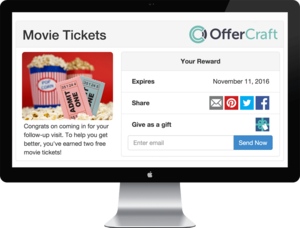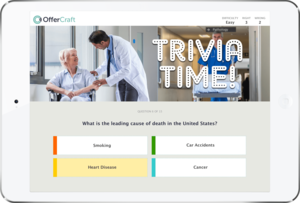A Winning Proposition: How Playing Games Can Change Patient Behavior
// By Aron Ezra //
 A specialty outpatient clinic was struggling with a problem common to many health care providers: Patients weren’t showing up for their appointments. The problem was particularly severe for this clinic, where the no-show rate was close to 50 percent. Doctors weren’t able to bill unless the patient showed up, and long stretches of the day went by without patients—or revenue.
A specialty outpatient clinic was struggling with a problem common to many health care providers: Patients weren’t showing up for their appointments. The problem was particularly severe for this clinic, where the no-show rate was close to 50 percent. Doctors weren’t able to bill unless the patient showed up, and long stretches of the day went by without patients—or revenue.
The clinic administrators tried everything to combat the problem. They double-booked appointment slots, but the no-shows didn’t follow a pattern. Sometimes both patients showed up, leading to long wait times. Or both didn’t show, leaving slots empty. Everyone was unhappy.
Do Penalties Work?
So administrators decided to charge patients for not showing up. While penalizing people somewhat reduced the no-show rate, it had some big drawbacks. It upset patients, many of whom felt they had legitimate personal reasons for missing their appointments. And if getting patients to pay their bills can be a challenge, you can imagine what it was like to get annoyed patients to pay a no-show fine. Patient retention started to become a problem.
When I met with the clinic administrators, they admitted they were in trouble. The clinic was bleeding money. If they couldn’t solve the no-show problem, the clinic was at risk of going under.
I encounter versions of this problem all the time. Hospitals can’t get their patients to log into their electronic medical records. Employees refuse to fill out a health-wellness assessment. Doctors struggle to get patients to take their pills. A study in the New England Journal of Medicine found that the problem of people in the U.S. mismanaging their medication leads to more than $100 billion every year in avoidable health care costs. Wow.
Getting patients to follow their doctors’ instructions is a moral imperative, and it’s also a financial one. Health care costs now eat up more than 17 percent of the U.S. G.D.P. McKinsey found that more than two-thirds of the nearly $3 trillion a year in health care costs in the U.S. are heavily influenced by consumer behaviors.
So how can we change our patients’ behavior?
The Lure of Rewards and Incentives
There are countless approaches out there, but one of my personal favorites is the use of games. Games typically yield double- and even triple-digit increases in compliance with the health care team’s desired action. And the cherry on top? Patients actually enjoy it. These initiatives don’t lead just to short-term behavior change—they often lead to long-term engagement and deeper excitement about their health care. It’s a true win-win for payers, providers, and patients.
Take the case of the specialty medical clinic. Rather than punishing their patients, my team suggested they try a carrot rather than a stick. Borrowing from ideas in behavioral economics, we designed a simple incentive program that cut their no-show problem in half.
Here’s how it worked: When patients finished their appointment and went to the front desk to settle their bill and make their next appointment, they were invited to play a Spinning Wheel game to win a mystery prize. The prize could be one of three things: a $10 gift card, a $50 gift card, or a $150 gift card. The patients wouldn’t find out what gift card they had won until they came back for their next appointment. Showing up was the only way to receive their prize.
The clinic’s no-show rate quickly dipped below 30 percent. Tens of thousands of dollars in additional revenue flowed in, and the gift card promotion cost a fraction of that. The clinic’s business was turned around by a simple game.
The Challenge of Influencing Patient Behavior

Software tools are being developed for providers to reward desired actions from patients, such as taking medication on time or showing up for a difficult appointment. This kind of behavior-modification marketing is becoming more important as payers move to a pay-for-performance model.
Today, clinicians and hospital administrators are increasingly being forced to figure out how to influence patient behavior. Tomorrow’s health care leaders won’t just need to care for patients—they will need to convince patients to get more involved in helping themselves. There are now very real financial rewards and penalties for physicians who succeed or fail at changing patient behavior. And there’s a new wave of technologies being developed to help organizations get it right. As in the clinic mentioned above, using interactive games and incentives is an easy—but also compelling—way to help motivate people to get more involved in their own health. In fact, while the concept is simple, the benefits can be multifold.
Research has continually backed the common-sense hunch that a more inspiring environment leads to better clinical outcomes. A 2011 report from the British Medical Association said that bingo, board games, art, and music help battle boredom, improve psychological well-being, and lead to better treatment results. Therefore, it makes sense that some organizations are embracing technology to help with their efforts. These electronic tools can also provide valuable ways to connect patients with their physicians or other clinical workers and make them more accountable for their behaviors in between medical visits.
Why Patient Engagement Matters More Today Than Ever
To understand how your organization might use games and incentives in your own day-to-day operations, it can be helpful to look at the bigger perspective and consider the growing importance of the patient experience and how people’s perceptions actually impact your performance ratings.
We’re now starting to see the care environment expand beyond the brick-and-mortar walls of our facilities. No matter how wonderful we make our waiting rooms and surgery suites, the healing process doesn’t end when a patient walks out the door—often that’s just the beginning. We’ve all known this for a long time, but until recently, the economic environment was such that there weren’t proper incentives to encourage caregivers to take responsibility for the entire continuum of care.
That’s finally changing. Medicare and Medicaid (along with the insurance companies) are beginning to move away from paying for procedures and toward paying for outcomes. Reimbursements are increasingly tied directly to how successful we are at getting patients to get healthier in the long run. While there are certainly real concerns about this approach, everybody agrees that the old payment model inadvertently rewarded more care rather than better care. This new results-based approach, called value-based purchasing or pay for performance (P4P), could become the dominant payment model in the coming years.
The Outcome Economy

Trivia games like this one are used by hospitals and clinics to educate their patients about the health risks associated with poor eating habits and lack of exercise, which can lead to heart disease. Some experts believe information is better retained when presented as part of a fun and engaging experience, such as a game.
It’s all part of a larger movement that Accenture calls “the outcome economy.” Achieving better outcomes requires true behavior change in the patients—and that’s no easy task. It means convincing patients to take responsibility for their care, whether it is listening to their doctors’ medication instructions, quitting smoking, or returning for a follow-up visit. Every vector and touchpoint in the health and wellness ecosystem is being re-examined as this new pay-for-performance model takes root.
Games and play make patients and employees more likely to engage with, and feel positively toward, an experience. It leads to better results.
For example, I’m often asked to build trivia games to help organizations educate and survey their target audiences. Compared to many traditional educational courses, we’ve seen people are much more likely to remember material if it’s presented in the form of a genuinely fun trivia game. And we’ve found even higher rates of retention when you add an element of competition, like allowing patients to compete against their past performance. This approach to education and surveying is particularly effective with millennial patients, who tend to prefer games of skill rather than those of chance.
Finding the Right Motivational Strategy
One of my recent clients was a consulting firm that was trying to get more of its employees to get their flu shot. There were big financial incentives for this. If more employees got their flu shot, absenteeism would go down and organizational health care costs would drop. The company had already created an incentive program. They gave employees who got their shot a $100 rebate on their health insurance premium for the following month. But it wasn’t working.
Problem was, a lot of the employees had their health insurance payments on autopay, and they weren’t even aware of how much they were paying each month. While $100 was a generous reward, it was presented in the most boring way possible.
I suggested the firm make the prize more visceral. Instead of $100 off their health insurance premium, we let people play a Scratch Off game to win all sorts of tangible prizes. The prizes ranged from watches to gift cards to iPads to extra vacation time. Staff could then share what they won with their colleagues. The average cost of the gifts? You guessed it: $100. Some cost less, some cost considerably more. The rate of people filling out their health wellness assessment or getting a flu shot saw double-digit improvements. Even though the incentive program didn’t cost the firm anything extra, it was far more effective. By making it a game, they saw compliance skyrocket.
Now that behavior change is being tied to payment, hospitals and medical groups are no longer viewing the concept as a “maybe someday” idea but rather as a core strategic priority going forward. As the C-suite begins adapting to this new pay-for-performance reality, health care marketers will play a key role structuring these programs. Marketers are already being asked to arm clinicians with tools to better communicate with their patients and persuade them to make good decisions. Moving forward, marketing executives will also need to identify the best ways to trumpet successes to regulators, to lawmakers, to donors, to peers, and, of course, to the community.
The Role of Health Care Marketers
Our goal as marketers has to be to transform an often-unpleasant experience into something more fun, engaging, and memorable. As Mary Poppins says: A spoonful of sugar really does help the medicine go down.
Health care-focused games certainly won’t solve everything. But they are a powerful—and still underused—tool that we’ll see much more of in the coming years. As P4P forces caregivers to take more responsibility for changing behavior, I believe games will play a small but crucial role in relieving suffering, improving key clinical and financial performance metrics, and bringing a lot more smiles to the faces of the people we work so hard to heal.
Some of the most common ways that I’ve seen and deployed games with marketing teams at hospitals and physician practices include:
- Rewards for repetitive actions such as taking medicine at a certain time.
- Trivia games to help educate about a complex topic.
- Games to pass the time during long healing periods.
- Group challenges that bring people into a community of fellow patients and require cooperation with peers to create a support network.
- Incentives for donors to donate to the hospital or clinic.
- Contests to keep nurses and doctors engaged during long shifts.
- Social games that can be played with other patients to reduce depression during a hospital stay.
- Fun experiences to enhance the doctor-patient relationship.
- Promotions to get patients to log into their electronic medical records portals so they stay engaged with their care.
- Mystery prizes that get patients to show up for their appointments on time.
And the list gets added to every day…
Aron Ezra is CEO of OfferCraft, a fast-growing technology startup that offers software geared to help engage patients in their own care. He is former Director at The Advisory Board Company, a health care research and consulting firm in Washington D.C., and past Vice President at Bally Technologies, one of the largest gaming companies in the world. Reach him at aezra@OfferCraft.com. For more information, visit www.OfferCraft.com.
